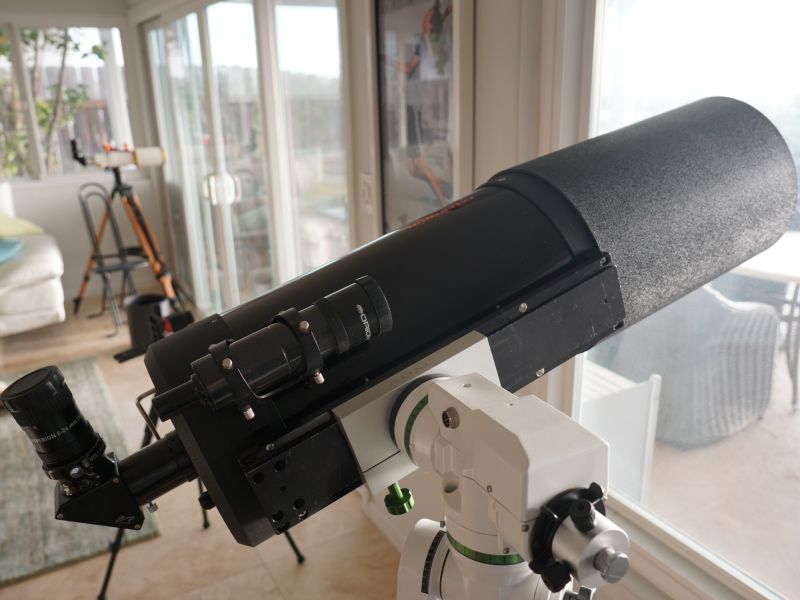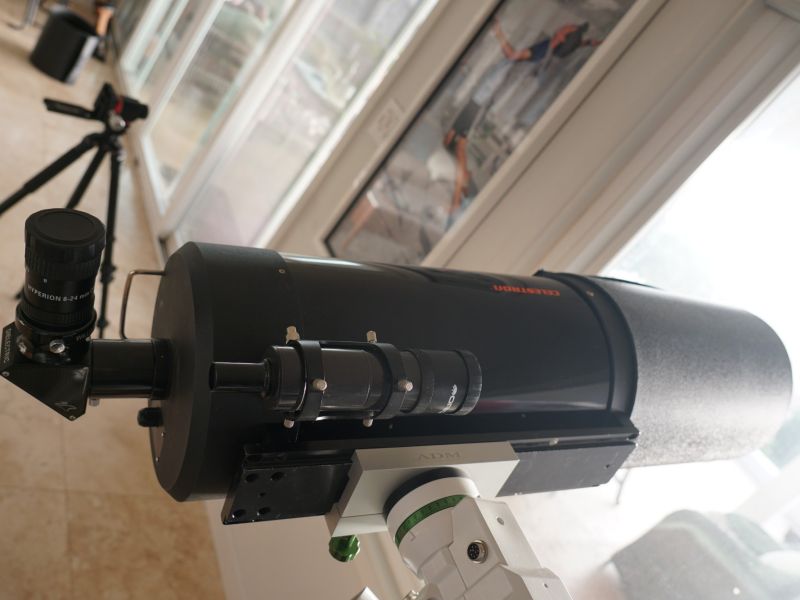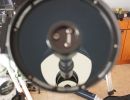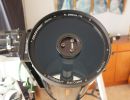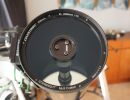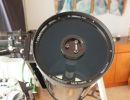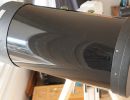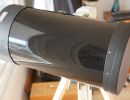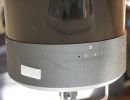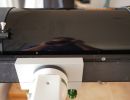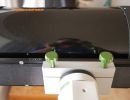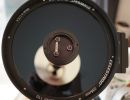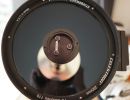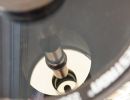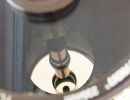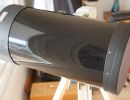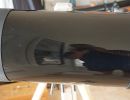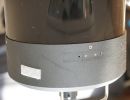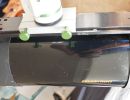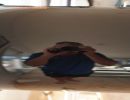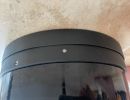- Details
- Category: Scopes
There are two primary types of mounts: equatorial and altitude-azimuth.
Altitude-Azimuth (alt-az) are straightforward and intuitive to beginners: they have the traditional up-and-down (altitude) and side-to-side (azimuth) movements.
Equatorial (EQ) mounts are like alt-az mounts but the vertical axis is adjusted so that it can align with the celestial pole. It makes pointing at a terrestrial object or a celestial target more complicated.
So what mount will you find on a beginner telescope? It depends. You would think alt-az, because it's easier to use, but many come with EQ mounts?
Why? What benefit does an EQ mount have over an Alt-Az mount?
- First and foremost, a motorized, properly aligned EQ mount is excellent for long-duration photographs. But they're expensive and generally not it the "beginner" price range.
- Second, a properly aligned EQ mount with the setting circles properly set can be used to find celestial targets by their absolute celestial coordiates or offset from a bright visual object. This was one way to find objects prior to the presence of easier-to-use phone apps.
- In essence, there is little value to saddling a beginner with an EQ mount. They're anachronisms for that audience. In fact, inexpensive scopes on EQ mounts are often called "The hobby killers."
"I have an EQ mount. Am I doomed?"
No! Some, but not all, EQ mounts can be adjusted to mimic an Alt-Az mount. The latitude adjustment screws/bolt - which are used to adjust the scope to align with Polaris - might be adjustable all the way to level with the ground. At this point, you have an Alt-Az mount: easy to point!
- Details
- Category: Scopes
Celestron 9.25
This Schmidt-Cassegrain has an almost mythical reputation. Is it deserved? The primary (pun!) difference between this scope and just about every other SCT is that it alone has an f/2.3 primary vs. an f/2.0 primary. F2.0 is awfully unforgiving in collimation and hiding figure errors. Does that make so much of a difference? Some think the quality control is better.
One thing that is undeniable: it's a big, heavy scope, considerably bigger and heavier than an 8" (23-lb).
- Details
- Category: Scopes
Dobsonians are great scopes, even the "dumb" ones (no electronics, no motors).
There are essentially three tiers of increasing capability/complexity/cost:
- Bare: no electronics, no motors. (video: Why Dobsonians are Great Scopes).
- Push-To: no motors, but encoders and a computer. The computer will help you Push To a target object. It will not track
- GoTo: electronics and motors. Your hand controller or app will allow you to command the scope to GoTo an object and track it. (video: GoTo Dobsonians: the Everything Scope?)
All dobsonian types can be pushed to a celestial target without requiring power or an electronic interface. This ability to use the scope without having to rely on electronics is important. If you're out of power or the electronics are misbehaving, you can still have a great night of observing. Some other types of scopes (mounts) are dead-in-the-water without power.
Electronics and motors, while they provide increased capability, do have a learning curve. Some are easy to learn and reliable and some are far more complicated.
Some manufacturers sell "Push-To Dobsonians". Orion's Intelliscope series are relatively inexpensive Push-To's. Many "bare" dobsonians can be upgraded with aftermarket encoders and DSC (Digital Setting Circles) kits. See Add-on Kits
- Details
- Category: Scopes
If your scope is computerized or motorized, you have to interact with the electronics.
There are three primary ways to interface:
- A Hand Controller (the HC)
- A phone or tablet Planetarium app
- Computer
"Amateur" Astrophotographers almost always have a laptop setup from which they can control the telescope, the camera, and all the other gear they use to take images that even the professional astronomers can't take (because they can't get the scope time required for sometimes hours and hours of exposure).
The computer smarts are most often presented to the observer via a Hand Controller (HC, for short). They generally have a couple of lines of text and a number of buttons. Most of your mass market manufacturers have similar hand controllers (Celestron, Meade, iOptron, Sky-Watcher, Orion, etc.).
A better experience for new and experienced users is, like everything electronic, your phone or table. Rich Graphic User Interfaces are not a fad, they're here to stay. Softare Planetarium Software, such as SkySafari, show a beautiful interactive sky map on your phone or table and can interface with your telescope. Telescope manufacturers are increasingly integrating a wifi interface to their onboard telescope computers. This is good.
For everyone else, a Hand Controller or Planetarium App is used:
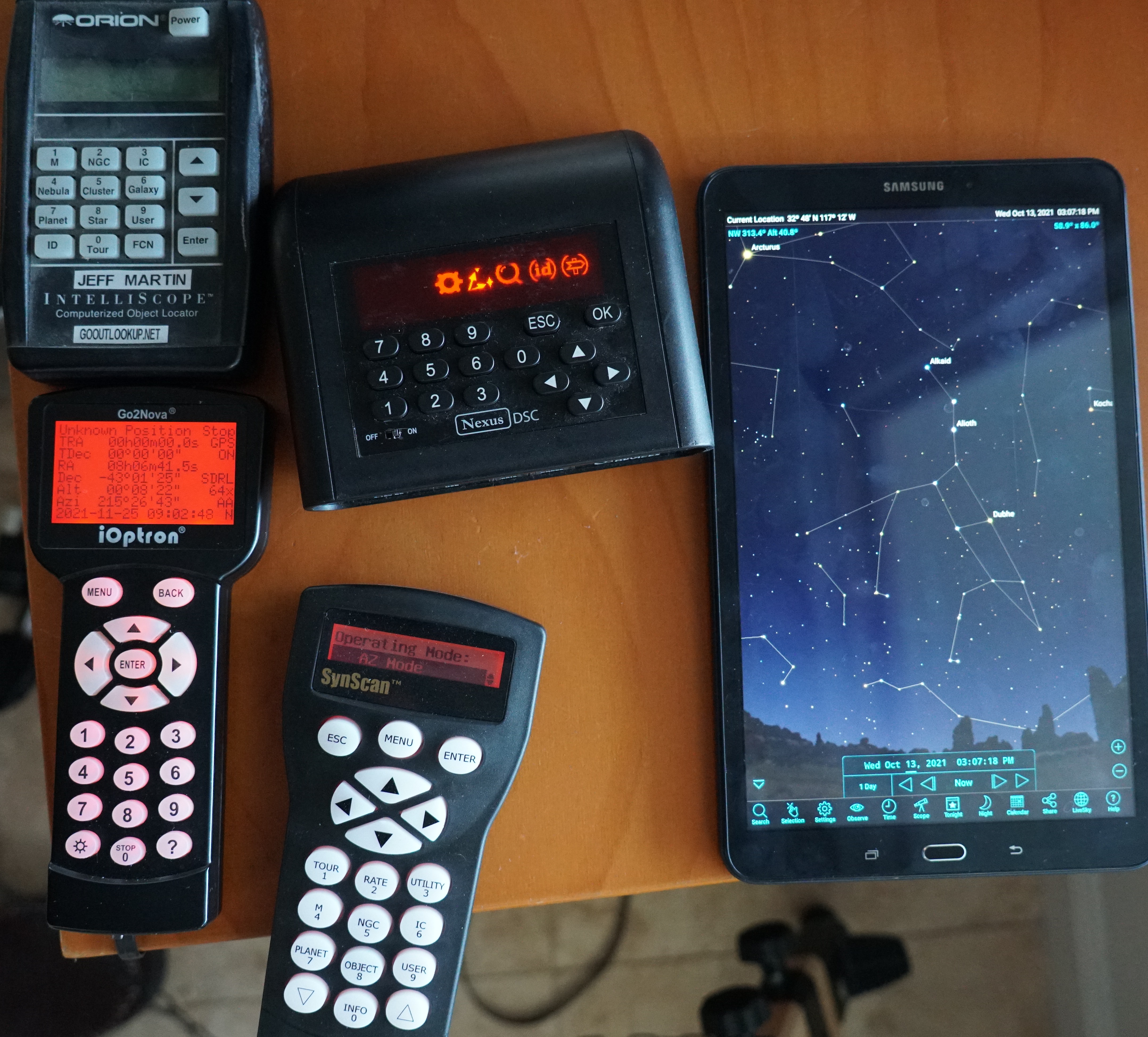
The Hand Controllers all have a learning curve and generally require looking up documentation (onboard help is limited).
Planetarium Apps also have a learning curve, but they're shorter and the interface is much better. Browsing the sky with an interactive map is fundamentally intuitive. You can even control GoTo scopes directly from the app. More here: Planetarium Apps
More and more manufacturers are integrating wifi into their telescope mounts to facilitate using Planetarium Software. Most newer mounts without integrated wifi allow attaching a dongle (!) that provides the wifi connection to the phone/tablet.
There is a bit of a setup to get them working (primarily getting the phone to recognize the wifi network and IP address). Once connected that first time, you're set.
Some observers abandon their hand controllers completely, using only their phone/tablet to control the scope.
Add-on Encoders
Add-on encoders and computers (Digital Settings Circles (or DSCs)) generally have a small computer box with a couple of lines of readout and a few buttons (some have the 0-9 keys as wells).
| The Argo Navis, a cult favorite has a couple of buttons and wheel. It's a very powerful Hand Controller, just as abacuses are powerful at math. Who wants to learn to use an abacus? |
 |
- Details
- Category: Scopes
Obsession Telescopes are the de facto standard in non-mass market quality dobsonians with premium optics.
(A dobsonian is generic term for a telescope resting within an inexpensive base wtih sliding azimuth and altitude bearings - rather than mated to a precision-geared mount head supported by a tripod).
Dave Kriege's The Dobsonian Telescope is the Bible for building your own dobsonian scope. "Obsession-clone" is the designation for the majority of dobsonians, either boutique-built or DIYer-built. Obsession-closes are the Jello and the Cokes of dobsonians. They're excellent.
They're excellent, but they're not small and they're not light. You generally roll them up a ramp into your truck or van to take them to your dark sky observing site.
Dave renamed these traditional "big box" dobsonians "Obsession Classics" when he introduced a second style of scopes: the Ultra-Compact series. The Ultra-Compacts are designed to be lighter and more portable.
I bought an Ultra-Compact 18" (UC18). At the time, it was the biggest scope I could use both at home and at a dark site. My home observing area was upstairs. I could carry the entire scope from upstairs to the car in two trips. I would not be able to do that with any 15" or larger Obsession-Classic or clone (removing the mirror and carrying separately would be required to keep the weight down. The third trip is less of an issue than removing and re-installing the mirror.).
Now that I don't observe from ground level at home, I can roll the scope intact to the car or to my observing area, the ability to carry the scope is far less important, though the transportability in a compact SUV or a sedan is still important.
The Ultra-Compact series is designed to fit in its ATA Travel Case, so that you can fly all over the world with it (checked-in, of course). That's the overriding engineering constraint. All designs are a compromise, and the major donor from the UCs' design is its ultra-compact lower hardware - broken into a very low-profile groundboard and a very complicated Virtual Mirror Box.
Where this immediately becomes an issue is the requirement for a custom dolly if you want to be able to quickly pop outside to observe.
Below our some videos about this very portable and capable (but potentially finicky) telescope:
- Here''s an Introduction to the UC18 and a custom dolly to make it fast to Grab-and-Go start observing.
- Here's why an Obsession Ultra Compact Needs a dolly
- Here's the most annoying challenge in using the UC18 with GoTo
- Details of the groundboard and Virtual Mirror Box.
The following are some customizations I made:
